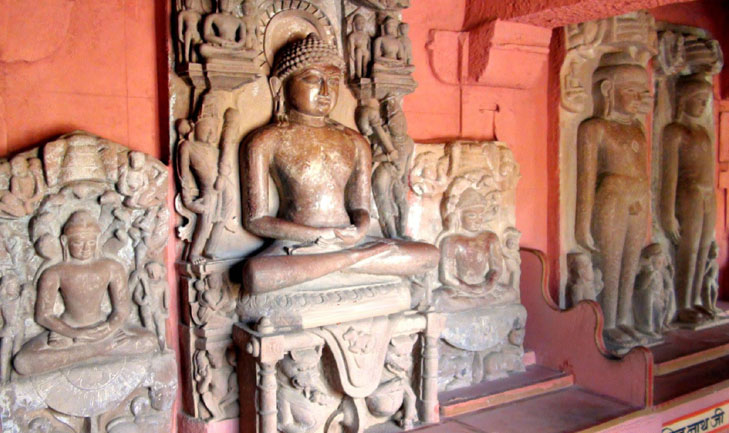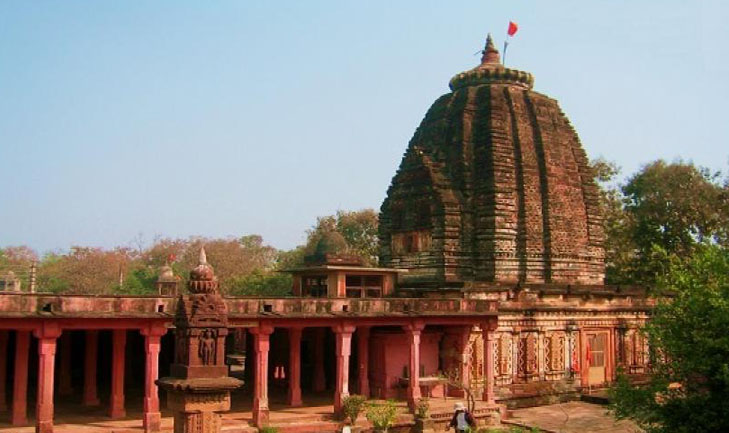Madhya Pradesh : Devgarh - Digambar Jain Tirth - Bh. Shantinath
|
Digambar Jain Tirth - Bh. Shantinath Devgarh, Madhya Pradesh
On the bank of river Betwa, at a distance of 123 Kilometers, spread on beautiful hillside this Digambar Jain tirth with 40 magnificent Jinalaya with 29 central pillars and 500 carved "Shilalekh" which portray an idea of divine place. It is situated on the Delhi-Mumbai rail road about 32 Kilometers. by road from Lalitpur. It is situated at western end of the Lalitpur range of hills. It carries great antiquarian, epigraphical and archaeological importance. This town has figured prominently in the history. Traces and remains of the Guptas, The Gurjara - Pratiharas, Gonds, Mughals, Bundelas, Marathas are implanted in the surrounding of the town. Principal attraction of the town are Darticcotar temple, a fine Vishnu temple of Gupta period and a group of old Jain temples. The exquisite execution and beautifully carved panels of the temple have called forth the remark that "few monuments can show such high level of workmanship, combined with ripeness and rich refinement in its sculptural effect as the Gupta temple at Deogarh". Perhaps of somewhat later origin but no less rich in artistic, archaeological and epigraphical value is a group of Jain temples situated inside the fort of Karnali on the hill overlooking the river Betwa. Some 31 of these Jain temples are still standing. The heavily ornamented ponds depict scenes and episodes from Jain mythology, myths and moments in lives of Jain Tirthankars. There are traces of outstanding craftsmanship, characteristic of Jain architecture and sculpture as the Manastambha (votive pillar), Ayagapatta (votive tablet), Pratima-sarvato-bhadrika (Jain image visible from all sides) and Sahastrakoot (Pillars Carved with Thousand Jain Images). The temple of Jain Tirthankar Shantinath is of unique importance of this place. The shape of this idol, in this temple is based on religious and ethical background. The Barah temple reminds one o the Chandela kings. Some other temples are Gajendra Moksha, Nar-Narayan and Vishnu. The art of Vaishnavi architect is said to be the soul of idol making in these temples. The style of construction of famous Dashavtar temple is a proof of the said fact. Apart from the idol of lord Shiva the sculpture and carvings of Pandava, Dropadi from the Mahabharat are of great interest. Some of the sculptures, related to Hindu holy book the Ramayan and that of lord Krishna are also kept here. There is an idol of Goddess possessing so many hands in the museum of Jain Dharmshala. This idol is very attractive and is of very high antique value. The languages used on different sculpture are Sanskrit, Prakrit or distorted Hindi. On the basis of inscriptions found in Deogarh it is derived that the art of idol making on stone dates back to the period of 919 to 1600 A. D. Some stone cutting tools of the ancient times have also been discovered. A special style of Gandhar facsimile can be found not only on idols of Jain Tirthankars but also on statues of men and women depicted in Deogarh. This spot is an attractive place on the bank of Vetravati. The top view, from temple side of river Betwa is very picturesque because the river has converted itself in a shape of a brook. The land is full of various type of trees of botanical and natural values. The thick forest on the hill is a haunt of wild animals. Red stone and firewood are the two objects of commercial importance available in this area. Ways of Transport & Stay : By air nearest Airport is Gwalior at a distance of 235 Kilometers from Lalitpur district. By train Lalitpur at 33 Kilometers. is the Nearest Railway Station on Delhi - Bombay railway line. By road It is well connected with regular Buses from Lalitpur Bus Station. You can stay at private Jain Dharmshala.
----------------------------------------------------- Mail to : Ahimsa Foundation |
||

